There is nothing that ruins the day quite like watching that slow-motion drop of your dog into the grass. You know EXACTLY what it means. Even before the wall of stench hits you in the face, your stomach sinks. Meanwhile, your dog’s mouth is open in a delighted doggie grin. They found a fresh patch of dung from SOMETHING. And it’s smeared ALL over the place. You groan. Not only will your dog need a bath, but their collar is going to need a trip into the wash. Dogs rolling in poop is one of the most troubling canine habits out there. And the worst part? No one quite understands where the impulse comes from! But everyone has a thought to contribute. That may not soothe your offended nose. But at least it’s interesting!
Scent-Rolling
We know dogs smell better than we do. Where we smell the stew on the stove, they can pick out every individual ingredient. Their sense of smell is thousands of times better than ours.
“It seems unbelievable they would want to cover themselves in a smell that even to my nose is unbearable, yet they do,” admits Simon Gadbois, an expert on canine behavior and scent-processing at Dalhousie University in Nova Scotia. We’ve all experienced dogs rolling poop at some point, usually to our horror. The routine’s frozen in our minds – and we’re usually too slow to prevent it.
There’s a park across the street from our house. It’s fenced, making it the perfect place to turn our Greyhound loose to really stretch her legs. But it’s also a favorite with a migrating Canada goose flock. Greyhounds are fast, but they also stop on a dime – usually far enough away that there’s no hope of interference. And watching her cock her head to the side, and then sink her shoulders…yup, all hope’s lost. Neither of us can run fast enough to prevent the inevitable. Before we know it, she’s rolling back and forth in a clump of GOOSE POOP. And she has a thin hair-coat, so it doesn’t stop things from getting EVERYWHERE.
You probably have similar stories of woe. But why – what causes dogs to roll in POOP? Good question.
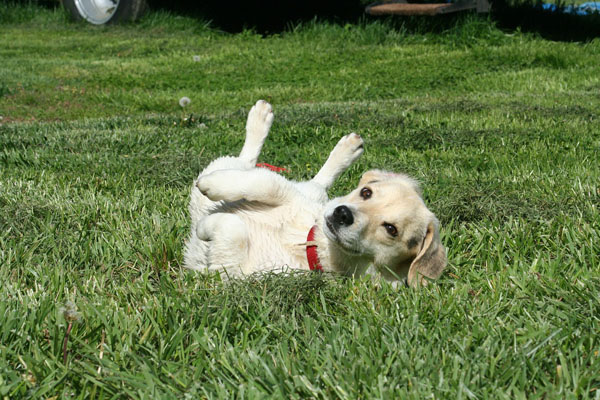
Dogs Rolling in Poop: The Eternal Question
It probably doesn’t make you feel better to learn that EVERY canine species performs this disgusting habit. That includes foxes, coyotes, and wolves. Scientists have documented canines rolling in any number of offal. (The irony of that word always tickles me) They’ll throw themselves down on rotting carcasses, feces, urine, and even trash. (And you thought dogs rolling in poop was bad!)
And while the science world racks up notes on the behavior, they haven’t decided WHY these canines – or your dog – decide to scent-roll. Everyone has a different theory, but none of them come out ahead of the other. Are they a combination of everything together? Does it depend on the size of the species? Or is everyone missing the mark completely?
Let’s walk through the theories, and then you can decide.
Dogs Rolling in Poop: Hunting Advantage
As with most dog behaviors, people like to believe actions are leftovers from wolf evolution. Since modern wolves continue rolling in poop (and other things), it’s a reasonable idea. Scientists suggested the act hid the natural predator scent during hunts. It made sense, especially if they picked the right feces to roll around in. For instance, beavers. (If you’ve never come across beaver scat, it REEKS. You won’t forget that scent any time soon) Or they could pick sheep poop, allowing them to blend in as a fellow prey item.
But there’s a problem with that theory. In 1986, biologists conducted a study where they provided wolves with several different scent options. Some were poop (from both herbivores AND carnivores), a few were food items, and others were artificial. The favorite choices? Perfume and motor oil! While those two WOULD smell strong, they wouldn’t help in the hunting process. In fact, such out-of-place smells would alert sheep or other prey items that something strange was approaching.
Then you come up with another wrinkle. Many wolves roll in cougar poop. Cougars are another PREDATOR. How would smelling like a predator (not a wolf, true, but still something lethal) help you hunt? “Here at Wolf Park, the wolves are willing to roll in the scent of alien canids and domestic cats. It raises a strong possibility that wild wolves may roll in predator scent, too. This would not be a helpful hunting disguise,” says Pat Goodman, the previous Senior Animal Curator at Wolf Park in Indiana.
So dogs rolling in poop to help them hunt? Maybe not so much.
Dogs Rolling in Poop: Hiding
In 2016, scientists set up remote cameras in California. They recorded grey foxes rolling around in cougar urine. (Okay, it’s not poop, but cougar urine is still a strong scent) The foxes weren’t hunting. Instead, the biologists believed the scent-rolling behavior was a disguise. The cougar urine hid them from coyotes, which are larger, and attack foxes to drive them out of an area. No coyote would ever take on a COUGAR, though. So maybe dogs rolling in poop is a way to hide in plain sight.
It’s an interesting idea, but the science community isn’t in agreement with this theory. They study red foxes at the University of Bristol (similar in size, but there’s no coyote to worry about – or cougars, for that matter). When exposed to a strong smell, red foxes exhibit the same behavior. Since they don’t have to worry about competition, why are they scent-rolling? Biologists think it’s a way to shout, “I’m here!” (Kind of the OPPOSITE tactic to the grey foxes) It’s a marking behavior.
Odds are your dog probably isn’t trying to hide. But they also don’t have the same scent glands as foxes. So is science on the right track here? Considering your dog usually BATHES in the poop instead of just dipping their head in it, it’s questionable.
Dogs Rolling in Poop: Announcement
Wolves, hyenas, and wild dogs follow a similar pattern to dogs rolling in poop: they COAT themselves in it. You can’t miss it (no matter how you try). That much scent is sure to carry. And science thinks the scent-rolling may let the other pack members know where something exciting is located. In the wild, it’s usually the site of food. When you find something amazing, you want to tell everyone else about it. Dogs can’t write down directions. So what suffices? SMELL!
“In the wolves I studied, if one started rubbing in something like a deer carcass, the whole pack would follow and rub in it. I’ve seen this in coyotes and foxes in the wild, too. It seems to become the odor you share will the others in the group.”
~Simon Gadbois, Canid and Reptile Behaviour and Olfaction Lab
Scent lingers and it’s easy to track. That means the remainder of the pack can follow the trail to the food (or whatever the canine happened to locate). It just happens that YOU are your dog’s pack.
It’s one of the more well-supported theories out there. Especially because it’s seen in all of the canine species.
Dogs Rolling in Poop: Other Ideas
Of course, the list doesn’t end there. A few other theories have popped up throughout the years. (Probably because dogs rolling in poop drives owners up the wall) They don’t all have as much support, though, and many have gotten struck down over the years due to a lack of evidence. But they’re fun to think about:
- Insect repellent (Not really sure who came up with that one)
- Waterproofing
- Doggie eau de cologne
- New tactile sensations
And then there’s the one that might make the most sense (though we hate to admit it): dogs simply get a kick out of dropping down into piles of manure. Their dopamine levels go up (that’s one of the neurotransmitters that make you feel good), and they feel joy. Probably NOT what you want to hear as you get hit with the sight and smell of your dog covered in poop. But likely closest to the truth.
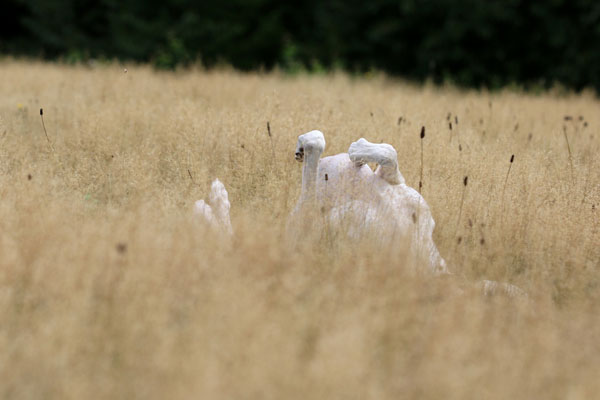
Preventing the Inevitable
No one wants to cope with their dog rolling in poop. They ALWAYS choose the worst time! You either just bathed them, have five minutes before you’re expecting company to drop by, or know there are piles of clean laundry sitting steps away. You HAVE to prevent this normal part of dog behavior from taking place. But how? You don’t want to confine your dog to the leash.
Not to worry. We have some solutions.
First and foremost, you want to clear YOUR yard of any poop hazards. Pooper scooper time will save you a lot of headaches. (If it isn’t there, they can’t roll in it)
Second, you know the signs. Every dog goes through the wind-up routine before they hit the ground and roll in poop. You usually see that slow-motion head tilt and drop. In general, dogs start with their head, then move to roll their entire bodies through the pile. So all you need to do is run a little interference.
Distraction is the name of the game. Does your dog know “Leave it?” Do they have a squeaky toy they adore? ANYTHING to break their focus on the poop (which you may or may NOT see!). Even keeping treats on hand to entice them away from that stinky smell can do the trick. It means stepping up your vigilance, but that’s better than coping with dogs rolling in poop, right?
Rolling Along
Science doesn’t have an answer to the question of dogs rolling in poop. Every time they claim, “Ah, ha!” the canine in question breaks the rules. (Motor oil, really? What wolf wants to smell like motor oil?) It IS possible that our canine companions simply get a kick out of the process. And we may never understand why.
But if we can spot that pause and head tilt, we can swoop in with a distraction before the slow-motion drop. At least that will save us from ONE MORE bath!

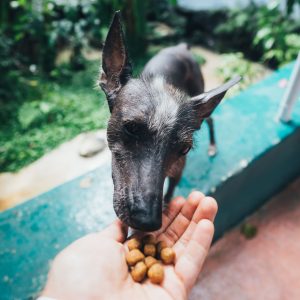
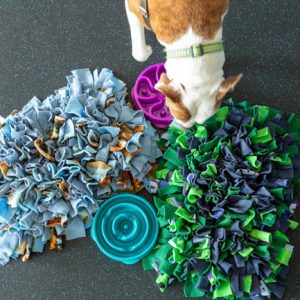
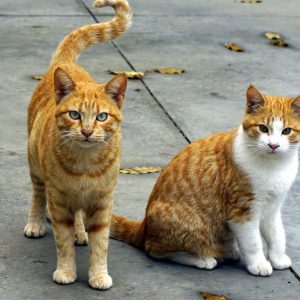

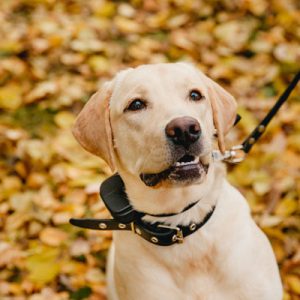
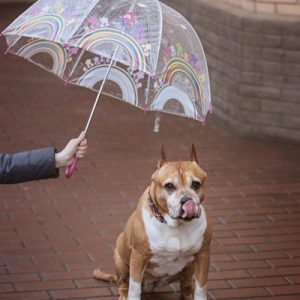
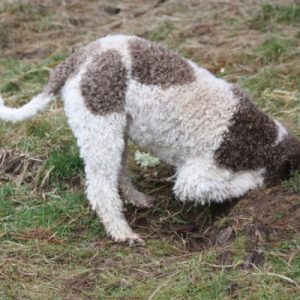
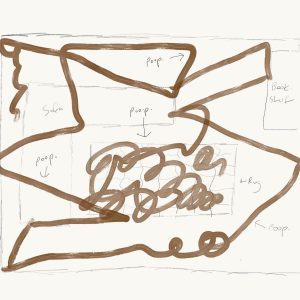
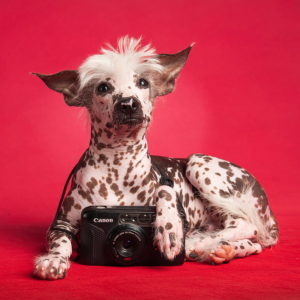
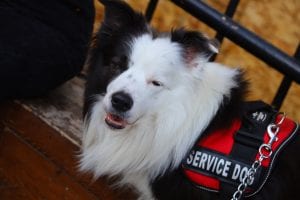
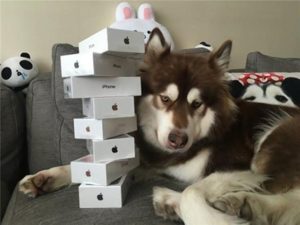
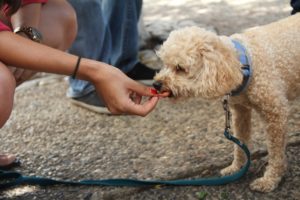
No comment yet, add your voice below!